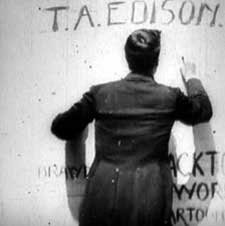 The "World Artist" of William Heise & James H. White's short-short Inventor Edison Sketched by World Artist (1896) alludes to the newspaper, the "World," not the planet, & to J. Stuart Blackton.
The "World Artist" of William Heise & James H. White's short-short Inventor Edison Sketched by World Artist (1896) alludes to the newspaper, the "World," not the planet, & to J. Stuart Blackton.
At the time Blackton was well known for his newspaper caricatures & his stage performances in instant caricature drawing. Public sketching was a normal part of stage entertainment in the day.
Many newspaper cartoonists did it, & George Melies Untamable Whiskers (1904) featured himself as a public chalk caricaturist whose drawings that magically cause his own appearance to change to match whatever he drew.
Similarly Winsor McCay as a Sunday comics artist had been doing public drawing exhibitions which quite naturally developed into his travelling shows featuring films like Little Nemo (1911) in which he is shown drawing characters that come to life.
So it was quite natural to make a film of public sketching, as for any other aspect of entertainment, & the Edison company always on the look-out for subjects that could do double-duty as advertisements for the Edision Company found this subject useful. Thus in this film, Blackton rapidly caricatures not presidents or other well known figures of the day, but only Thomas Alva Edison.
The Edison caricature-film was unexpectedly very, very popular with the public, inducing Blackton, a showman at heart, to start up his own film company, Vitagraph, which was at first a rival of Edison, but was soon coopted by Edison.
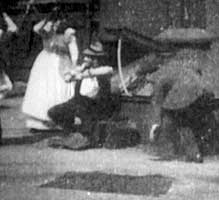 J. Stuart Blackton's usual cameraman was Albert E. Smith. It is generally understood that Blackton was the creative energy, Smith the technician & businessman. Together they founded the Vitagraph film company.
J. Stuart Blackton's usual cameraman was Albert E. Smith. It is generally understood that Blackton was the creative energy, Smith the technician & businessman. Together they founded the Vitagraph film company.
One of their earliest efforts was Burglar on the Roof (1898). In this short-short, a thief is shown coming through a skylight only to be discovered by tenants, who attack him, the woman with her broom, a couple guys with direct physical assault.
Blackton's The Thieving Hand (1908) runs to six minutes. A one-armed beggar is panhandling. An act of honesty so impresses a passing gentleman that he takes the beggar to a prosthetics store & buys him a new limb.
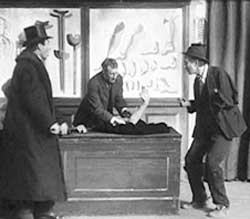 The awfully realistic looking hand & forearm will turn out to have a mind of its own. A criminal mind at that, expressed with a mix of real arm posing as a prosthetic & very well done stop-motion animation. The awfully realistic looking hand & forearm will turn out to have a mind of its own. A criminal mind at that, expressed with a mix of real arm posing as a prosthetic & very well done stop-motion animation.
The panhandler's honesty is fustrated by the naughty handm which soon gives him reputation of a pickpocket, so he pawns the limb.
In the pawnshop window the limb crawls around stealing rings for its fingers then escapes from the shop.
The arm goes looking for the one-armed man, attaching itself to him while the beggar is asleep, inevitably getting him arrested for stealing all the rings.
In prison there's another one-armed fellow, a confirmed criminal. So the arm abandons the honest man & attaches itself to the crook. Funny stuff, though tragic for the honest tramp.
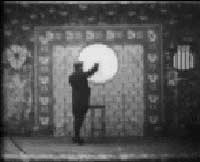 Congress of Nations (1900) was filmed on the Vitagraph rooftop in New York. A magician on a stage whirls a disc about to show there's nothing funny about the disc, & hangs it on the wall. He sets a tiny table in front of it, then grabs a flag out of the circle & shakes it into a living soldier who marches about a bit.
Congress of Nations (1900) was filmed on the Vitagraph rooftop in New York. A magician on a stage whirls a disc about to show there's nothing funny about the disc, & hangs it on the wall. He sets a tiny table in front of it, then grabs a flag out of the circle & shakes it into a living soldier who marches about a bit.
The magician repeats the action & gets a second soldier. A third flag from a third nation is pulled out of the hoop & a third soldier shaken out of the flag.
Eventually there are six soldiers, the last one Chinese, upon whom all the others leap. It ends with a patriotic tableau for America featuring Uncle Sam & Liberty among others. This one's not a high point for Blackton.
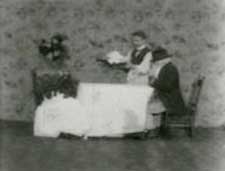 The Mysterious Cafe, or Mr. and Mrs. Spoopendyke Have Troubles with a Waiter (1901) is similar to Edwin S. Porter's An Animated Luncheon (1900), only this time it is the furniture rather than the food that acts up.
The Mysterious Cafe, or Mr. and Mrs. Spoopendyke Have Troubles with a Waiter (1901) is similar to Edwin S. Porter's An Animated Luncheon (1900), only this time it is the furniture rather than the food that acts up.
The whiskery old gent manages to seat himself successfully at the table, but as his large wife begins to sit, the chair moves in the blink of an eye to the top of the table, & the woman tumbles to the floor. Her husband rushes to help, but she vanishes & reappears in his chair.
There follows a series of madam & chair teleportation gags until at last they're both comfortably seated. As they lean forward against the table, it vanishes, & they tumble toward each other.
When things calm down, their meals arrive, & they begin devouring food like starved piggies. The table refuses to stay in one place, however, & their meals vanish too, so they take the tablecloth, angrily wrap the waiter in it, & lift the wrapped waiter to the table.
The whiskery old gent beats the living daylights out of the wrapped waiter, pounding him with a chair, while the missus climbs up on the table & jumps up & down on him. They then unwrap him & he looks a bit woozy from the abuse.
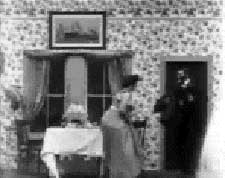 Another dining comedy arranged by Blackton & Smith has a more elaborate set than The Mysterious Cafe but with the same wallpaper. The arrangement is clearly by the same set dresser who did the artfully off-center An Animated Luncheon, but probably not The Mysterious Cafe. Another dining comedy arranged by Blackton & Smith has a more elaborate set than The Mysterious Cafe but with the same wallpaper. The arrangement is clearly by the same set dresser who did the artfully off-center An Animated Luncheon, but probably not The Mysterious Cafe.
Called Maude's Naughty Little Brother (1900), it takes place in Maude's dining room. She has set the table & now waits, fanning herself, for her beau's arrival. He steps through the door & bows a greeting.
Seated at the table, they do not see Maude's baby brother sneaking into the room & tying a rope around the suitor's coattails. He then crawls under the table to attach the other end of the rope to the tablecloth.
About then Maude's father comes in & clearly dislikes the man courting his daughter. He attacks the beau, who leaps up & drags the chair & tablecloth with him, the dinner tossed all over the floor.
The father sees what his young son has done & while the beau flees, the lad gets a sound thrashing, while Maude weeps.
Not as good natured as most of Blackton's film; the practical joke has no humorous effect or reward for anyone.
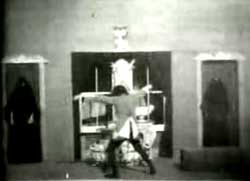 For The Clown & the Alchemist (1900), the clown one-ups the alchemist in magical prowess, running about wacking the helpless alchemist with a wooden sword, riding a rainbarrel like a pony then vanishing, hugely annoying the only slightly less antic alchemist.
For The Clown & the Alchemist (1900), the clown one-ups the alchemist in magical prowess, running about wacking the helpless alchemist with a wooden sword, riding a rainbarrel like a pony then vanishing, hugely annoying the only slightly less antic alchemist.
Having had enough, the alchemist has cowled servants bring out a large mystical basin, waving his wand about the whole while.
The clown arises from the basin & the cowled servants catch him. But he puts up a wonderful fight & again disappears. The cowled servants hunker down on their knees & when the alchemist grabs their cowled robes, the garments are empty.
The alchemist puts the robes in the basin & a sheet-spirit rises & turns into the clown. Giving up, the alchemist flees. The clown climbs in a suitcase & the suitcase vanishes with him in it.
Quite an amusing rapid-paced action-comedy, one wonders if the clown wasn't originally intended to be a devil, but the imaginative & upbeat Blackton felt the faustian thing was getting old hat. With a clown in place of Mephisto, the tone completely changed to a big joke on the self-important alchemist, rather than a threat to his soul.
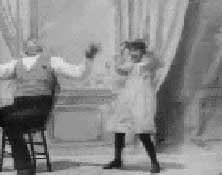 Most early films of mischievous children are about prankster boys, but Little Mischief (1899), filmed on the Vitagraph rooftop, is of the L'il Iodine or Baby Snooks school of troublemaking girls.
Most early films of mischievous children are about prankster boys, but Little Mischief (1899), filmed on the Vitagraph rooftop, is of the L'il Iodine or Baby Snooks school of troublemaking girls.
The little girl sneaks up behind her father & tickles his ear with a straw. He keeps reading his paper & tries to shoo away what he assumed was a fly. Little Mischief is beside herself trying not to let out an audible laugh.
She tickles him time & again until he's having a veritable fit thrashing his arms at the imagined fly & finally falls off his chair, his daughter laughing & hopping with delight.
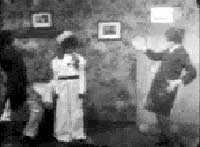 Poorly preserved early imitation of George Melies' trick photography coming out of Paris, The Mesmerist & the Country Couple (1899) shows a man & wife visiting a mesmerist in his home.
Poorly preserved early imitation of George Melies' trick photography coming out of Paris, The Mesmerist & the Country Couple (1899) shows a man & wife visiting a mesmerist in his home.
The country gentleman bonks the mesmerist on the head with an umbrella to get his attention, as the fellow was apparently napping in his chair. It's such an odd opening moment.
The mesmerist uses his power to make the man who bonked him lay on the floor, stand on his hands, float in the air, become stiff as a board, with a few added stunts that require would seem to require skills other than hypnotism, such as throwing clothes at the hypnotised man so that he is instantly wearing them.
It's then the woman's turn to be hypnotized into vanishing & reappearing, much more a recreation of a magic act than a hypnosis act. In a film that is only about a minute & three quarters length, it packs in a lot of swift events.
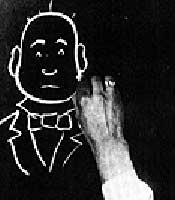 Before ever he made a film, Blackton had been a vaudeville cartoonist. A standard type of act of the day was called "lightning sketching" & many newspaper cartoonists did these performances, as did caricaturists in general.
Before ever he made a film, Blackton had been a vaudeville cartoonist. A standard type of act of the day was called "lightning sketching" & many newspaper cartoonists did these performances, as did caricaturists in general.
He has come to be regarded as 'the father of animation" since his encounter with Thomas A. Edison put it in his head to use stop-motion animation for the sake of making his lightning-drawings move.
The Enchanted Drawing (1900) is a minute & a half example of early animation. An illustrator (Blackton) is shown standing in front of a well lit canvass, drawing the caricature head with face.
He also draws a bottle of wine & a glass, removes these from the canvas as they become real, has himself a drink, then gives the drawing of a face a sip from the bottle.
The frowning face instantly grins from delight in the wine. Our artist draws a tophat on the head, then quickly removes it from the drawing as a real hat for his own head, & also swipe's the caricature's cigar.
This causes the face to scowl, so the caricaturist restores the cigar, hat, wine, & wine-glass to the drawing, making the drawing very happy.
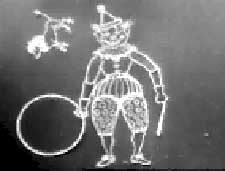 The title of Humorous Phases of Funny Faces (1906) materializes in fragments building to a whole, then the bulk of this animated film begins. Blackton's hand is seen drawing a head & torso of a a man, then a woman's head & torso draws itself.
The title of Humorous Phases of Funny Faces (1906) materializes in fragments building to a whole, then the bulk of this animated film begins. Blackton's hand is seen drawing a head & torso of a a man, then a woman's head & torso draws itself.
The two drawings smile at each other, & sundry animated events occur, like the gent's hair growing longer, a tophat appearing on his head, & the woman getting distraught as the man's cigar increasingly clouds & obscures the whole drawing just before the artist's arm reaches in with an eraser.
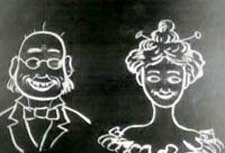 The next drawing in chalk is of a fat man with bowler & closed umbrella. When the drawing is finished self-manifesting, the fat man flips his umbrella & tips his hat. The next drawing in chalk is of a fat man with bowler & closed umbrella. When the drawing is finished self-manifesting, the fat man flips his umbrella & tips his hat.
A messy sworl of chalk next appears. Most of the chalk disolves away, revealing the profiles of an elderly man & woman smiling at one another.
The gent stops smiling, & the outline of their profiles vanishes away like a threads pulled out of a cloak.
Next up is a drawing of a clown. He juggles his hat, then plays with a trained miniature lion (or little dog with a lion's mane toupee). The mini-lion can do balancing & jump through a hoop. The artit's hand for a final time appears to erase the mini-lion & the clown. A superb & effectively whimsical piece of animation.
copyright © by Paghat the Ratgirl
|
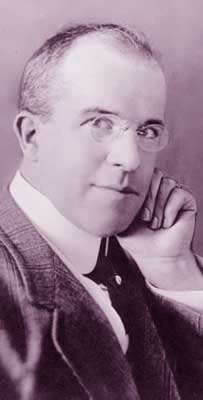


 The awfully realistic looking hand & forearm will turn out to have a mind of its own. A criminal mind at that, expressed with a mix of real arm posing as a prosthetic & very well done stop-motion animation.
The awfully realistic looking hand & forearm will turn out to have a mind of its own. A criminal mind at that, expressed with a mix of real arm posing as a prosthetic & very well done stop-motion animation.







 The next drawing in chalk is of a fat man with bowler & closed umbrella. When the drawing is finished self-manifesting, the fat man flips his umbrella & tips his hat.
The next drawing in chalk is of a fat man with bowler & closed umbrella. When the drawing is finished self-manifesting, the fat man flips his umbrella & tips his hat.